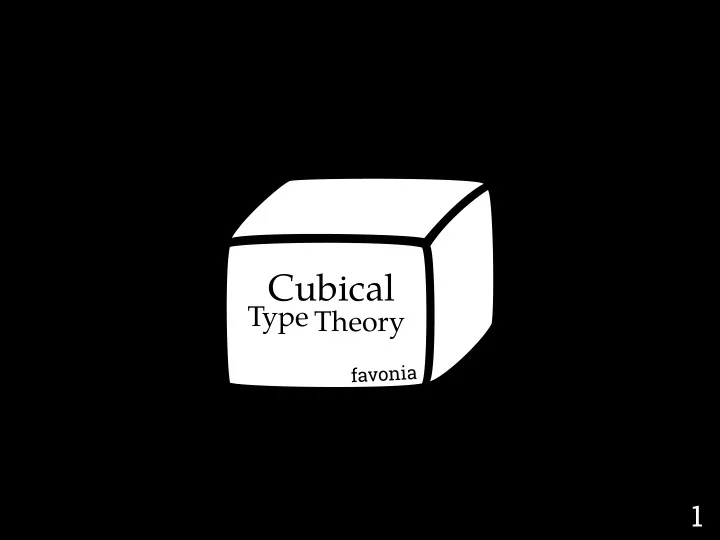

Cubical Type Theory favonia 1
2
t f 2
⟙ t f 2
⟙ ⟘ t f 2
⟙ ⟘ t f 4 0 7 3 8 1 5 2 … 6 ℕ 2
⟙ ⟘ t f 4 0 7 3 8 1 5 2 … 6 … ℕ → ℕ ℕ 2
3
3
3
3
3
3
1 6 7 4 5 9 8 2 3 0 quotient 4
1 6 7 4 5 9 8 2 3 0 quotient 4
1 6 7 4 5 9 8 2 3 0 quotient 4
universe 5
id not universe 5
id id ⟙ + ⟙ not swap universe 5
⟘ id id ⟙ + ⟙ not swap ℕ → ℕ … ℕ universe 5
p o o l base circle (homotopy theory) 6
I. Cubes 7
M A 8
M A 1 0 8
M A i 1 0 i: 𝕁 ⊦ M : A 8
M A i j i: 𝕁 , j: 𝕁 ⊦ M : A 9
M A n-cube i 1 : 𝕁 , i 2 : 𝕁 , ..., i n : 𝕁 ⊦ M : A 10
M i j 11
M[1/j] M[1/i] M[0/i] M[0/j] M i j 11
M[1/j] M[1/i] M[i/j] M[0/i] M[0/j] M i j 11
M N N 0 1 A path types functions from 𝕁 12
M N N 0 1 A i: 𝕁 ⊦ M : A M[0/i] ≡ N 0 : A[0/i] M[1/i] ≡ N 1 : A[1/i] λ i.M : Path i.A (N 0 ,N 1 ) 13
M N N 0 1 A i: 𝕁 ⊦ M : A M[0/i] ≡ N 0 : A[0/i] M[1/i] ≡ N 1 : A[1/i] λ i.M : Path i.A (N 0 ,N 1 ) r: 𝕁 P : Path i.A (N 0 ,N 1 ) P@r : A[r/i] P@0 ≡ N 0 : A[0/i] P@1 ≡ N 1 : A[1/i] 13
M N N 0 1 A i: 𝕁 ⊦ M : A M[0/i] ≡ N 0 : A[0/i] M[1/i] ≡ N 1 : A[1/i] λ i.M : Path i.A (N 0 ,N 1 ) r: 𝕁 P : Path i.A (N 0 ,N 1 ) ( λ i.M)@r ≡ M[r/i] : A[r/i] P@r : A[r/i] P ≡ λ i.P@i : Path i.A (N 0 ,N 1 ) P@0 ≡ N 0 : A[0/i] P@1 ≡ N 1 : A[1/i] 13
function extensionality almost trivial h : Π (x:A). Path(F(x), G(x)) λ i. λ x.h(x)@i : Path(F, G) 14
II. the Book 15
Id A (M,N) N M A re fl M : Id A (M,M) the only generator 16
zero base case suc induction step mathematical induction re fl re fl case “J”: induction principle for Id 17
univalence as axiom Id U (A, B) B A A ≃ B (A ≃ B) ≃ Id U (A, B) 18
univalence as axiom Id U (A, B) B A A ≃ B (A ≃ B) ≃ Id U (A, B) (A ≃ B) → Id U (A, B) 18
p o o l base circle base : circle loop : Id circle (base, base) 19
y l loop n o h e t r w i J … fl univalence re fl case normalization in danger* J(loop) ≡ ??? 20 *most experts believe the normalization fails
Leave Id alone! Id/Path should re fl ect existing paths, not inducing new ones 21
p o o l i loop i base circle base : circle i: 𝕁 ⊦ loop i : circle loop 0 ≡ base : circle loop 1 ≡ base : circle 22
univalence as a type V i (A, B, E) B A E : A ≃ B (when i = 0)* *see [AFH] (not recommended as the fi rst paper to read) 23
Judgmental framework paths of (then internalized by Path/Id) 24
III. Compositions 25
concatenation? 26
concatenation? 26
concatenation? 26
Kan fi lling for cubes 27
Kan fi lling for cubes 27
constant concatenation Kan fi lling for cubes 27
fi llers can be done by higher-dimensional composition* Kan composition 28 *technical limitations apply; see papers for real (!) math
fi llers can be done by higher-dimensional composition* k j i 29
fi llers can be done by higher-dimensional composition* j=1 ⊦ M j=1 : A i=1 ⊦ M i=1 : A i=0 ⊦ M i=0 : A k j=0 ⊦ M j=0 : A j i 29
fi llers can be done by higher-dimensional composition* j=1 ⊦ M j=1 : A i=1 ⊦ M i=1 : A i=0 ⊦ M i=0 : A k j=0 ⊦ M j=0 : A j i k=0 ⊦ M k=0 : A 29
i=0 ↪ M i=0 i=1 ↪ M i=1 comp k.A M k=0 : A[1/k] j=0 ↪ M j=0 j=1 ↪ M j=1 M j=1 M i=1 M i=0 k M j=0 j i M k=0 30
U a composite in a universe is a type itself which has its own composition operator 31
A : M 𝕁 : i ⊦ x a t n y s models in other higher toposes? a model equivalent to “Standard” the homotopy theory? 32
Agda --cubical https://github.com/agda/cubical redtt https://github.com/RedPRL/redtt 33
One Path to Enlightenment (in this order) Homotopy Type Theory: Univalent Foundations of Mathematics Syntax and Models of Cartesian Cubical Type Theory [ABCFHL] https://github.com/dlicata335/cart-cube/blob/master/cart-cube.pdf Axioms for Modelling Cubical Type Theory in a Topos [OP] (expanded version) https://arxiv.org/abs/1712.04864 Computational Semantics of Cartesian Cubical Type Theory [A] (chapter 3, still changing everyday) https://www.cs.cmu.edu/~cangiuli/thesis/ 34
Recommend
More recommend